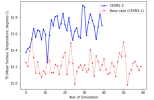czarakas@uw_edu
New Member
Hi,
I'm running a fully coupled simulation at 2 degree resolution (compset: 1850_CAM60_CLM50%BGC_CICE_POP2%ECO%ABIO-DIC_MOSART_CISM2%NOEVOLVE_WW3_BGC%BDRD, resolution: f19_g17), as a hybrid run branching from year 401 of the 2 degree PI control (b.e21.B1850.f19_g17.CMIP6-piControl-2deg.001). I'm using CESM2.2 with the CLM PPE tag - I'm using this model version instead of CESM2.1 because I'd like to compare results with the CLM5 PPE, and the CESM2.1.z series is incompatible with the CLM version being used by the CLM5 PPE. So far I have run this simulation for 40 years, and it is hotter than the PI control I branched from (global mean temperature is 14.5-14.6, compared with ~14.0 in b.e21.B1850.f19_g17.CMIP6-piControl-2deg.001). Is this warmer PI global temperature consistent with model changes from CESM2.1 to CESM2.2, or does it suggest some problem with how I set up the case?
And if the warmer PI global temperature is expected, could I reasonably start a transient historical run after ~40 years partial spin up, which I think is long enough for the surface ocean and LAI to equilibrate? Or would I need to run the whole fully coupled simulation for long enough for the deep ocean to equilibrate to this warmer base climate (which would not be feasible for this project given timing constraints and our computing allocation)?
The case directory for the simulation above is ~/cesm_cases/coupled_PPE/COUP0000_1850spinup and the run script I used to set up the case is here.
Thanks!
I'm running a fully coupled simulation at 2 degree resolution (compset: 1850_CAM60_CLM50%BGC_CICE_POP2%ECO%ABIO-DIC_MOSART_CISM2%NOEVOLVE_WW3_BGC%BDRD, resolution: f19_g17), as a hybrid run branching from year 401 of the 2 degree PI control (b.e21.B1850.f19_g17.CMIP6-piControl-2deg.001). I'm using CESM2.2 with the CLM PPE tag - I'm using this model version instead of CESM2.1 because I'd like to compare results with the CLM5 PPE, and the CESM2.1.z series is incompatible with the CLM version being used by the CLM5 PPE. So far I have run this simulation for 40 years, and it is hotter than the PI control I branched from (global mean temperature is 14.5-14.6, compared with ~14.0 in b.e21.B1850.f19_g17.CMIP6-piControl-2deg.001). Is this warmer PI global temperature consistent with model changes from CESM2.1 to CESM2.2, or does it suggest some problem with how I set up the case?
And if the warmer PI global temperature is expected, could I reasonably start a transient historical run after ~40 years partial spin up, which I think is long enough for the surface ocean and LAI to equilibrate? Or would I need to run the whole fully coupled simulation for long enough for the deep ocean to equilibrate to this warmer base climate (which would not be feasible for this project given timing constraints and our computing allocation)?
The case directory for the simulation above is ~/cesm_cases/coupled_PPE/COUP0000_1850spinup and the run script I used to set up the case is here.
Thanks!


